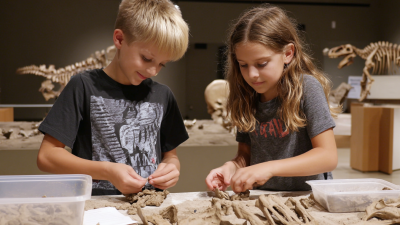Unlocking Curiosity: How Stem Science Kits Inspire Young Innovators to Explore the World
Table of Contents
- How to Choose the Right STEM Science Kit for Your Child's Interests
- How to Foster a Growth Mindset Through Hands-On Experimentation
- How to Create a Stimulating Learning Environment with STEM Kits
- How to Encourage Collaborative Learning and Teamwork with Science Projects
- How to Integrate STEM Learning into Everyday Life Beyond the Kit
- FAQS
- Conclusion
- Related Posts
In today's rapidly evolving educational landscape, the importance of fostering curiosity and innovation among young minds cannot be overstated. STEM Science Kits have emerged as essential tools in stimulating interest in science, technology, engineering, and mathematics, with studies indicating that hands-on learning experiences significantly enhance a child's engagement and retention of knowledge. According to a report by MarketsandMarkets, the global STEM education market is projected to grow from $1.5 billion in 2020 to $3.5 billion by 2025, reflecting a heightened demand for resources that encourage creative problem-solving and critical thinking. Jinhua City Dukoo Toys Co., Ltd., a leader in the toy manufacturing sector since 2009, understands this trend deeply. With nearly 13 years of experience and a dedication to customizing archaeological toys that inspire young innovators, Dukoo Toys is well-positioned to contribute to the growing market of STEM Science Kits, helping children explore and discover the wonders of the world around them.

How to Choose the Right STEM Science Kit for Your Child's Interests
When it comes to nurturing a child's curiosity and creativity, selecting the right STEM science kit is crucial. A recent report from the National Science Foundation indicates that early exposure to science-related activities significantly enhances problem-solving skills and cognitive development in children. Parents should consider their child’s interests, whether it's robotics, chemistry, or biology, as various kits cater to different inclinations. For instance, a 2023 survey by the Educational Research Center revealed that children engaged in hands-on STEM activities are 75% more likely to pursue STEM careers later in life.

Additionally, it's important to assess the kit's complexity and age appropriateness. According to the STEM Education Coalition, overly complicated kits can lead to frustration, while kits that are too simple may not hold a child's attention. The optimal choice not only aligns with their current interests but also challenges their intellect. Look for kits that encourage critical thinking and allow for creative experimentation, ensuring that the learning experience remains both engaging and educational. By making an informed choice, parents can foster a lifelong love for learning and innovation in their children.
How to Foster a Growth Mindset Through Hands-On Experimentation
Hands-on experimentation is a powerful catalyst for cultivating a growth mindset in young innovators. When children engage with STEM science kits, they are encouraged to embrace challenges and view failures as vital stepping stones to success. Each kit offers a unique opportunity to explore scientific principles in a tangible way, allowing kids to experiment, hypothesize, and re-evaluate their approaches. This iterative process of trial and error not only enhances their problem-solving skills but also fosters resilience, teaching them that persistence often leads to mastery.
Moreover, through hands-on activities, children learn to appreciate the value of curiosity and creativity in learning. Experiments that excite them spark questions, encouraging deeper exploration of concepts. As they manipulate materials and observe outcomes, they begin to understand that knowledge is not just about memorization, but about discovery and innovation. This experiential learning approach helps shift their mindset from a fixed perspective to one that celebrates growth, making them not just consumers of knowledge, but active participants in their own educational journeys.
Unlocking Curiosity: How Stem Science Kits Inspire Young Innovators to Explore the World
| Experiment | Age Group | Skills Developed | Materials Needed | Duration |
|---|---|---|---|---|
| Volcano Eruption | 6-10 years | Critical Thinking, Problem-Solving | Baking soda, vinegar, food coloring | 30 minutes |
| Solar Oven | 8-12 years | Creativity, Engineering | Pizza box, aluminum foil, plastic wrap | 1 hour |
| Crystal Growth | 10-15 years | Observation, Patience | Sugar, water, jar | Several days |
| Egg Drop Challenge | 9-14 years | Engineering, Teamwork | Egg, various materials (straws, tape) | 1 hour |
| Simple Circuit | 7-12 years | Logic, Electricity Basics | Battery, wires, bulb | 30 minutes |
How to Create a Stimulating Learning Environment with STEM Kits
Creating a stimulating learning environment with STEM kits involves integrating hands-on activities that spark curiosity and foster engagement. To start, it’s essential to organize a dedicated space where young innovators can explore freely. This space should be equipped with various STEM kits that cater to different interests, such as robotics, chemistry, or environmental science. By providing clear instructions and allowing children to experiment independently, we encourage them to ask questions and seek solutions, further enhancing their learning experience.
Additionally, incorporating collaborative projects can significantly enhance the learning environment. When children work together, they share ideas, collaborate on problem-solving, and learn from each other’s strengths. Facilitators can introduce challenges that require teamwork, allowing kids to develop critical social skills while engaging with the STEM kits. By fostering a culture of exploration and teamwork, we create an enriching atmosphere that not only instills knowledge but also inspires young innovators to continue exploring the world around them.
How to Encourage Collaborative Learning and Teamwork with Science Projects
Collaborative learning is an essential aspect of nurturing young innovators as they explore the vast realms of science and technology. Science projects provide a unique platform for students to engage with their peers, fostering teamwork and encouraging the sharing of ideas. By working together on hands-on experiments and challenges, children learn to value diverse perspectives, enhancing their problem-solving skills and creativity.
Moreover, initiatives like science fairs or group projects serve as a catalyst for promoting effective communication among students. This collaborative environment not only helps them develop essential social skills but also instills a sense of responsibility toward one another's learning journeys. Educators play a pivotal role in guiding students through this process, ensuring that each team member contributes and learns from the collective experience. Encouraging a spirit of cooperation in these scientific endeavors ultimately equips young innovators with the confidence and collaborative skills necessary to tackle future challenges in an increasingly interconnected world.

How to Integrate STEM Learning into Everyday Life Beyond the Kit
Integrating STEM learning into everyday life is essential for nurturing the next generation of innovators, and it goes far beyond just using science kits. According to recent studies, children learn best when they can connect concepts to real-world applications. For instance, engaging in simple home experiments can foster creativity and critical thinking. A survey by the National Science Teachers Association indicates that students who partake in hands-on STEM activities tend to perform better in math and science subjects, driving home the importance of practical integration.
Moreover, the use of technology in education has transformed the landscape of learning. Adaptive Learning Technologies are being introduced into classrooms, allowing personalized educational experiences tailored to individual student needs. A study published in the Journal of Educational Psychology reveals that students utilizing technology-enhanced learning environments exhibited a 30% increase in their problem-solving skills and a significant reduction in learning gaps. By embedding STEM principles into daily routines—such as cooking chemical reactions or using budgeting apps to teach mathematics—parents and educators play a pivotal role in developing the skills necessary for future innovations.
FAQS
: Parents should evaluate their child's interests, the kit's complexity, and age appropriateness to ensure it aligns with their current inclinations while providing a suitable challenge.
Engaging in hands-on STEM activities increases the likelihood of children pursuing STEM careers later in life, with surveys indicating a 75% higher chance of doing so.
A growth mindset helps children embrace challenges and view failures as opportunities for growth, and hands-on experimentation with STEM kits encourages this mindset by allowing them to explore, hypothesize, and learn through trial and error.
Children enhance their problem-solving skills and resilience through experimentation, as well as learn to appreciate curiosity and creativity in the learning process.
Parents can engage children in home experiments, cooking, or using budgeting apps, connecting STEM concepts to practical real-world applications to enhance learning.
Technology in education allows for personalized learning experiences that cater to individual student needs, resulting in significant improvements in problem-solving skills and reduced learning gaps.
By embedding STEM principles into daily routines and facilitating hands-on learning experiences, parents and educators are crucial in developing children's innovative skills for the future.
An overly complicated kit may lead to frustration, while a kit that is too simple may fail to engage the child's interest, making it important to find a balance that is appropriately challenging.
Through hands-on experimentation, children learn that knowledge is about discovery and innovation, shifting from a fixed mindset to one that values growth and active participation in their education.
Studies show that children who participate in hands-on STEM activities perform better in math and science subjects, highlighting the importance of practical integration for academic success.
Conclusion
STEM Science Kits serve as powerful tools to ignite curiosity and inspire young innovators. When choosing the right kit, it's essential to align the selection with your child's interests, whether in biology, chemistry, or physics. Hands-on experimentation not only promotes a growth mindset but also transforms learning into an engaging experience. By creating a stimulating learning environment and encouraging collaborative projects, children can thrive in teamwork, enhancing their social and scientific skills. Furthermore, integrating STEM learning into everyday life amplifies the effectiveness of these kits, ensuring that education extends beyond the confines of structured play.
At Jinhua City Dukoo Toys Co., Ltd., we have a rich history in crafting specialized toys, including STEM Science Kits, that encourage exploration and discovery. With over a decade of experience and significant growth, our commitment is to provide innovative educational products that captivate young minds globally.
Related Posts
-

5 Smart Tips to Enhance Learning with Stem Science Kits
-

Why Every Young Explorer Needs an Archaeological Digging Kit
-

How to Create Exciting Learning Experiences with a Dinosaur Fossil Dig Kit
-

10 Essential Tips for Creating the Perfect Outdoor Dig Pit for Kids
-

Exploring the Demand Surge for Christmas Archaeology Toys at the 2025 China Import and Export Fair
-

Ultimate Guide to Sourcing Multi-Player Dig Adventure Games for Global Markets
Blog Tags:

